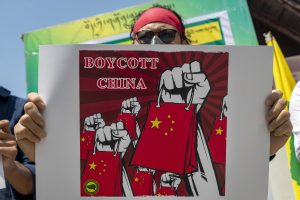Of the many engagements that U.S. Secretary of State Antony Blinken undertook in New Delhi recently, two stood out. At a roundtable gathering of around seven civil society leaders, Blinken interacted with the Dalai Lama’s former interpreter, Geshe Dorji Damdul. Then, separately, Blinken met with a representative of the Dalai Lama, Ngodup Dongchung.
The fact that America’s top diplomat met with Tibetan representatives on Indian soil has inevitably raised eyebrows. India has long tried to walk a tightrope on Tibet, so as to not offend Chinese sensibilities.
While the Dalai Lama has operated out of India in exile since 1959, New Delhi’s official policy has always been that the Tibetan community in the country is not allowed to undertake any political activity. In 2016, a planned conference of Chinese dissidents in New Delhi, including Tibetans, was cancelled after India revoked their visas at the last minute.
Two years later, several events had been planned to commemorate the 60th year of the Dalai Lama’s flight to India. But the Narendra Modi government issued a circular asking its officials not to share the stage with the Tibetan leader, and various events were then moved out of New Delhi.
But after last year’s unprecedented border clashes, many believe that India is pursuing a paradigm shift in its Tibetan policy, aimed at retaliation against Beijing. One noted foreign policy analyst, Sreeram Chaulia, for instance, thinks that Blinken’s meetings were “definitely coordinated” with the Indian government. “Since China says it does not accept India’s sovereignty over much of Ladakh and Arunachal Pradesh,” he said, “conveying that India will not meekly recognize Tibet’s current status as an inalienable part of China … will send strong countervailing signals to Beijing.”
Yet if India hopes to gain strategic leverage through its Tibetan community, it will need to articulate its positions with greater clarity and consistency. New Delhi’s frequent flip-flops on political engagement with the Tibetans will not help cultivate Tibet as a bargaining chip against China. If Tibetans see India’s policy as a mere knee-jerk reaction to the dynamic border equation with China – rather than as a policy born out of more consistent and reliable principles or values – New Delhi is unlikely to gain their trust, for fear of more flip-flops.
India also has a broader challenge on its hands: the future of the Tibetan community in India itself. While India grants citizenship to Tibetans born in India before 1987, those born after that year will only qualify if they have an Indian parent.
The statelessness of many Tibetans has various consequences. Most of them struggle to access job opportunities in the country, lack the right to own businesses or buy land, and face obstacles when trying to travel abroad because they lack passports.
On their part, some Tibetan leaders are fearful that, if India grants them citizenship, Tibetans will need to move out of the exclusive colonies in which they currently live, and integrate with mainstream Indian society. That could mean a weakening in their sense of community and their commitment to the Tibetan cause, some fear.
Yet, in the absence of economic opportunities, younger Tibetans are now becoming increasingly restless, and New Delhi will need to meet their aspirations sooner rather than later, while keeping their commitment to Tibet alive through its own political support.
Meanwhile, alive to the strategic threat that India and the U.S. could pose through their engagement with Tibet, Beijing is already looking to insulate itself.
Over the last few years, China has tried to “Sinicize” its own Tibetan population, including through the resettlement of Han Chinese people in Tibet. Last week, President Xi Jinping visited Tibet to flag off various infrastructure projects and policies. In line with Beijing’s policy of Sinicization, Xi called for the “blending [of] ethnic groups” and “adapting Tibetan Buddhism to socialism with Chinese characteristics.” The Chinese president also talked about promoting Mandarin as the primary language in the region.
Earlier this year, China also raised militias in Tibet to counter Indian troops along the Line of Actual Control.
Beijing’s policy, in the long term, is to tighten control over its Tibetan population, while cutting off the links that Tibetans in India have to their homeland. In the context of its border troubles with China, New Delhi must respond by committing stronger support – political and economic – to the 100,000 Tibetans in India and their cause, cultivating a reliable constituency of support among them, and strengthening their links to their homeland.
Under President Joe Biden, Washington has made clear that it wants to counter the threat from China by engaging with Chinese dissidents, from Tibet to Taiwan. New Delhi should join Washington in a more committed and coherent manner.

































